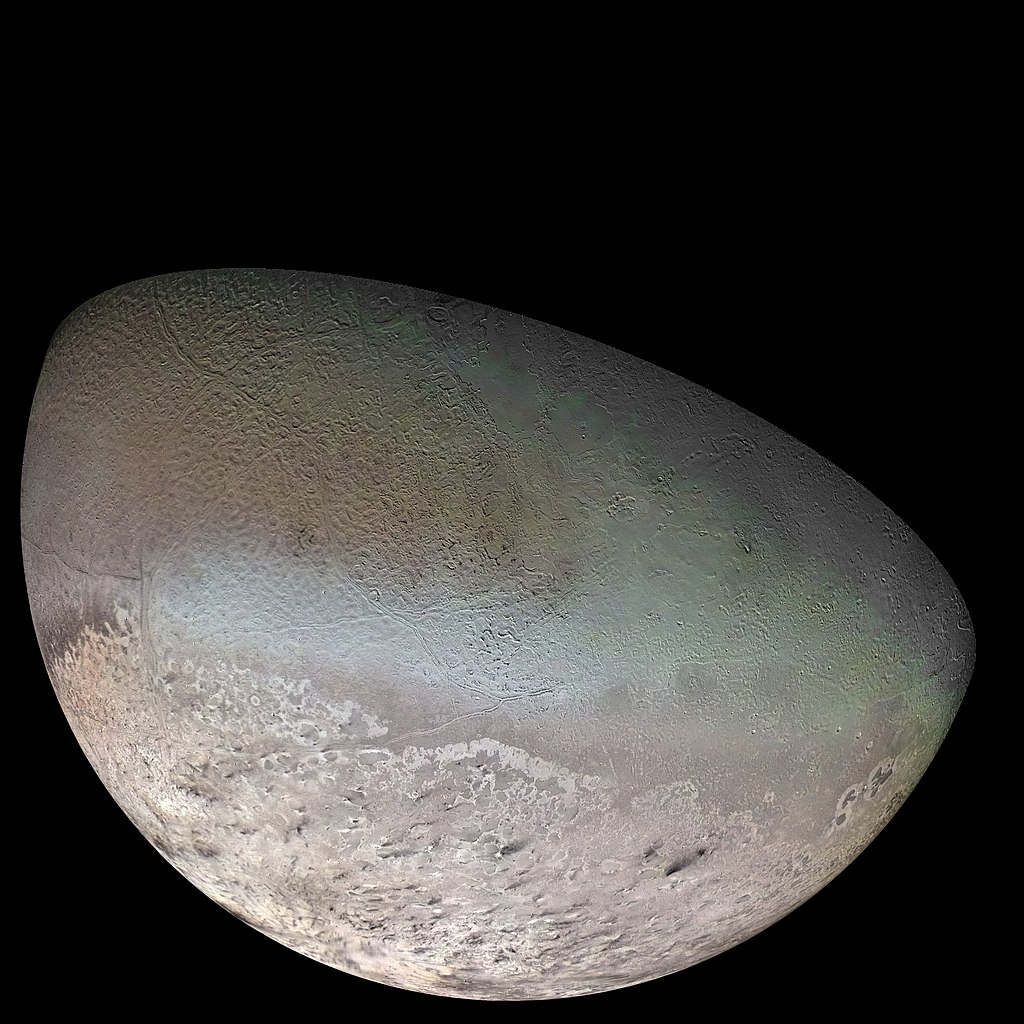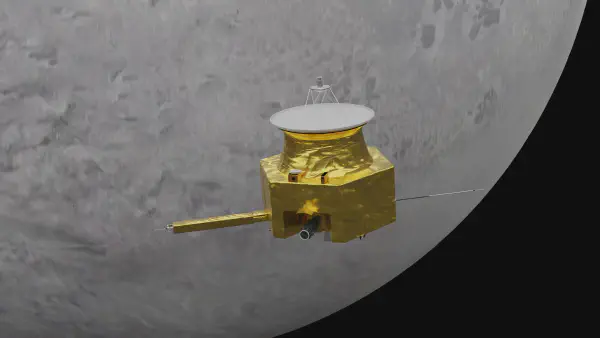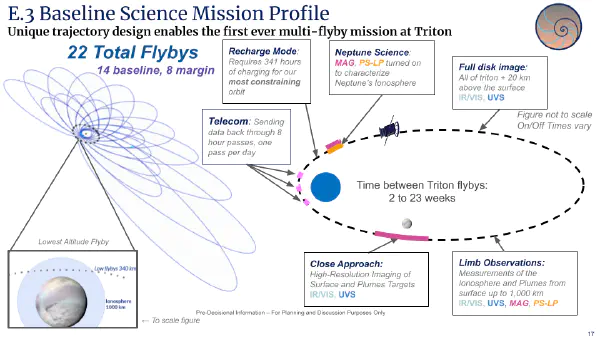Planetary Science Summer School
The cantaloupe-looking moon of Neptune, Triton, has been on the to-return list of planetary scientists since Voyager 2 flew by in 1989. Voyager spotted plumes, walled plains, and craters, to name a few surface features. But one of Triton’s most unique properties is its retrograde orbit (the opposite direction of the rest of the solar system), which suggests it is a body captured from the Kuiper Belt, the ring of small bodies on the solar system’s edge.
 NASA / Jet Propulsion Lab / U.S. Geological Survey, Public domain, via Wikimedia Commons
NASA / Jet Propulsion Lab / U.S. Geological Survey, Public domain, via Wikimedia Commons
Planetary Science Summer School is an 11-week mission design course where a group of graduate students and early career folks explore the corners of the solar system by developing a mock mission proposal. Weekly webinars and group work whittle down research questions to a capable spacecraft design capable of answering them. The final week is spent with JPL experts in Pasadena to finalize the design and present it to a review panel.
We designed our mission starting with the wishlist from the Decadal Strategy for Planetary Science and Astrobiology 2023-2032. We chose to propose a Triton mission for the upcoming New Frontiers 5 Announcement of Opportunity.
Nautilus
What is Triton made of? Where did it come from? Our team aimed to discover these fundamental attributes. Our spacecraft’s projected instrument suite was designed to investigate observable quantities that could help determine the extent of a subsurface ocean, the ionosphere, core, geomorphology, and plumes.
Our conceptual instrument suite would be composed of instruments with heritage from similar missions:
- JUICE Jovian Dynamics and Composition Analyzer
- MAVEN Langmuir Probe and Waves
- MAVEN Magnetometer
- New Horizons Alice Ultraviolet Imaging Spectrometer
- New Horizons Ralph Visible and Infrared Imager

Getting the spacecraft to Triton was one of the most challenging tradeoffs we had to make. Early in the mission design process, the team was hopeful for an orbiter architecture but ready to demote to a multi-flyby architecture. The incredible engineers at JPL presented a beautiful trajectory, enabling 22 possible flybys affording the mass of our instrument suite and its supporting spacecraft with the ability to achieve our science goals. See our profile below.

Project Management
New Frontiers 5 calls for a total cost of $1.2B (we were allowed a bit more for the exercise) distributed over different phases of mission development. That’s a lot of money. It’s up to the Project Manager (me!), Principal Investigator, and other administrative folks to convince the proposal reviewers that the funds will be spent wisely. Fortunately, the Announcement of Opportunity outlines the requirements for the proposed mission.
Of course, there is a formal way to declare exactly how your scientific goals can be distilled and connected with the spacecraft you design: the Science Traceability Matrix (STM). This is where the iterative design process got interesting. Not only must the spacecraft fly, but each instrument on the spacecraft must be justified by a scientific goal, and each goal must be attainable with a spacecraft’s instrument. The STM is a way to track these dependencies (and I’ll share ours when it is approved).
I was responsible for ensuring instruments could answer our scientific questions and that we had the power, data, and cost budget to fit them on the spacecraft for the initial architecture study. We built a spreadsheet of instruments used on similar missions and quantified the measurements needed to prove hypotheses. When we were told near the beginning of the session that Team X used Microsoft Excel to build missions, my heart collapsed. When we reached the culminating week, I realized that I had created a comparable (being incredibly generous) tracker in Google Sheets. If I had to start over, there would have been a lot more Python and SQL involved.
A project manager needs to determine the specific risks to the mission, and things like alien encounters likely wouldn’t make the list. However, the long cruise duration. Our proposed mission would launch in 2042, arrive by 2057, and close out in 2060. I no longer wonder why there are so many greying scientists. How would a project ensure continuity for that long? We would have to include funds and programs to ensure that there were still motivated people around to do the science when the time came. Unfortunately, that money also needs to be in the budget. These details were not the engineering or scientific risks I expected but learned to appreciate.
The Experience
The team I worked with was brilliant. I was fortunate enough to learn a planet’s mass of information and new ideas to which I had never previously been exposed. In the human spaceflight space, we focus on keeping people alive and healthy in space. Why they are there comes next. To be thrown into a design process driven by the characteristics of a (possibly) lifeless planet 30 AU away was dizzying. Is it more important to answer as many questions as possible about Triton? Or should we dedicate all resources to answering one question as definitively as possible? Our reviewers thought both, and I agree, but someone has to pay for it, and I don’t have a billion dollars in my pocket.
Presentation
We presented posters at AGU!
Sign Up!
If you’re interested apply here! Whether you’re a planetary science expert, engineer, or otherwise space-interested person, you’re guaranteed to learn more than you ever thought.
Disclaimer: All statements in this post are my own and do not represent those of NASA or JPL.